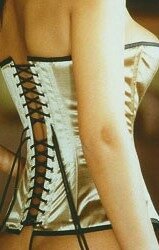Your cart is currently empty!
Vintage bloomers, slips and camisoles
vintage style bloomers, split bloomers and half slips as seen on deadwood and the gem saloon
 |
 |
 |
 |
 |
 |
|
Bloomers got their name from Amelia Bloomer. She wanted to promote clothing that whist sticking to the views and fashions of the period also allowed women more choice and variety in the underwear that was available. Bloomers and loose cotton camisoles became a practical solution for womens underwear to provide practicality and flexibility. We sell authentic long and short bloomers as well as open crotch bloomers and cotton vintage style camisoles. Vintage bloomers are as popular as ever especially with the series deadwood |
 |
 |

FRENCH KNICKERS Lace Trim £19.00 Available in 4 Colours Black / Black lace White / White Lace Red / Black Lace Pink / White Lace |

Frou Frou Briefs Frou Frou Lace Back detail £29.00 Available in 4 Colours Black / Black lace White / White Lace Red / Black Lace Pink / White Lace |
|
WHAT ARE FRENCH KNICKERS French Knickers are a type of lingerie. The term is predominantly used in the UK to describe a type of underwear worn from the hip. They cover the hip, part of the upper thigh and part of the buttocks. They are regarded as more comfortable and sexier than thongs by some. In the mid to late 1970s French Knickers, designed by Janet Reger and others, brought erotic and exotic style to lingerie. Of course major manufacturers through the 1980s to present day latched on to the trends. Now luxury lace and silk French Knickers are available in high street stores. |
WHAT IS FROU FROU The word frou-frou is first recorded in English in the early 1870s. Its original sense was ‘a rustling, as of silk on a woman’s dress’. An example that the Oxford English Dictionary cites from 1871: “With a frou-frou of soft silk she arose.” This sense also appears as a verb–“frou-frouing skirts,” for example. The current sense, ‘elaborate or frilly decoration, as on women’s clothing’, is also found for the first time in the 1870s. The word frou-frou is a borrowing from French, in which it is first found in the 1730s. It is ultimately of imitative origin the word is supposed to sound like the rustling of silk. |